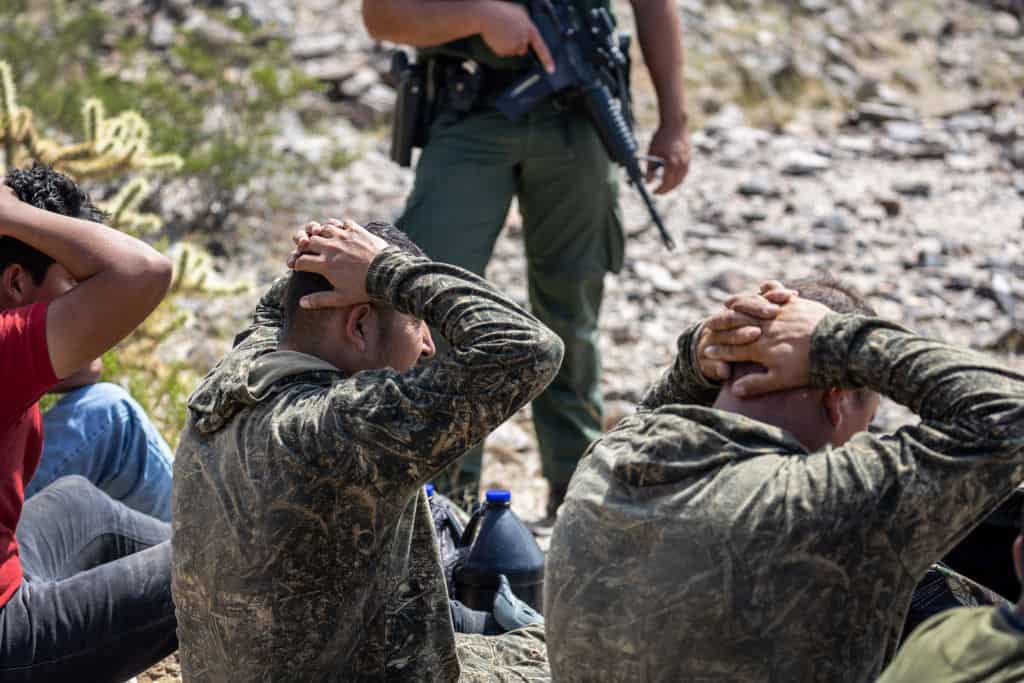In its work monitoring cases of alleged abuses committed by Customs and Border Protection (CBP) and Border Patrol personnel at the U.S.-Mexico border, WOLA is aware of 10 cases of fatalities since 2020 that may—pending the final outcome of investigations, complaints, and litigation—have violated the agencies’ Use of Force policy.
These are cases involving CBP officers or Border Patrol agents, in which:
- personnel used deadly force under circumstances in which the immediacy of the threat of death or bodily injury remains unclear; or
- personnel may have failed to prevent the death of an individual in custody.
The Department of Homeland Security’s (DHS) Use of Force policy, most recently updated on February 7, 2023, spells out a set of very narrow circumstances under which the Department’s personnel, such as CBP officers and Border Patrol agents operating at the U.S.-Mexico border, may use deadly force or discharge a firearm. (Border Patrol is an agency within CBP.)
Officers and agents “may use deadly force only when necessary, that is when the LEO [law enforcement officer] has a reasonable belief that the subject of such force poses an imminent threat of death or serious bodily injury to the LEO or to another person.”
There is no circumstance in which the policy permits personnel operating on land to fire warning shots. Shooting at vehicles, as a warning or to disable them, is also prohibited. Firing at a vehicle is only permitted if using deadly force against a driver who poses an imminent threat of death or serious bodily injury, as above.
Fatalities
The cases of which WOLA is aware, since 2020, include:
- July 9, 2020: A CBP officer and a contract security guard shot and killed an unidentified Mexican man, who they reported was wielding a knife, just inside the U.S. border at the Calexico, California port of entry. It remains unclear whether this man posed an imminent threat to any other individual, or whether the situation could have been de-escalated without loss of life.
- October 23, 2020: Border Patrol agent Ryan Gonsalves shot and killed David Angel Villalobos Baldovinos, a Mexican citizen, following a reported “scuffle” at the San Ysidro port of entry south of San Diego. The circumstances and severity of the “scuffle” remain unclear; Gonsalves suffered “minor injuries, though police did not elaborate on the extent of the injuries,” the San Diego Union-Tribune reported.
- January 29, 2021: A Border Patrol agent shot and killed Diosmani Ramos, a Cuban migrant, as he emerged from the Rio Grande in Hidalgo, Texas. Helen Diéguez, Ramos’s partner, told Univisión that when Ramos reached the river bank, the agent was pointing a gun at him. “Diosmani grabbed a stone, the officer told him to drop it, and when the young man did not do so, he shot him in the chest.” When Ramos fell to the ground after being shot, the agent “told him again to drop the stone, he did not drop it because he was on the ground doubled over in pain, and then the agent shot him five more times… If what they wanted was to grab him, there were many ways to do it, not by shooting him six times in the chest,” Diéguez said.
- May 14, 2021: Three Border Patrol agents shot and killed San Diego resident Silvestre Vargas Estrada through the windshield of his car, following a pursuit in Campo, California. The San Diego County Sheriff’s report on this case refers to a “confrontation” but not to Vargas attempting to use deadly force.
- August 2, 2021: A Salvadoran man, Jason González Landaverde, died while in Border Patrol custody in a rural area near Eagle Pass, Texas. CBP reported that he became “unresponsive” after being restrained for having become “unruly.” González spent an hour shackled on the ground while agents awaited a transport vehicle, during which time he passed away. “The autopsy reported the cause of death was acute renal failure,” a February 1, 2023 report from the DHS Inspector-General explained, “which the medical examiner believed was most likely due to a combination of dehydration and hyperthermia (abnormally high body temperature).”
- February 19, 2022: Border Patrol agent Kendrek Bybee Staheli shot and killed Carmelo Cruz Marcos, a citizen of Mexico, at night on a desert trail near Douglas, Arizona. According to a statement from the Cochise County, Arizona Sheriff’s Department, Staheli claimed that Cruz resisted capture “then ran approximately six feet away before picking up a large rock and turning back towards the agent making a throwing motion with the hand that held the rock.” The agent then “fired his weapon an unknown number of times as he was in fear for his life and safety.” The County Sheriff’s Office report on the incident, shared by the Intercept in May 2022, cited an English-speaking migrant who had accompanied Cruz. That witness claimed that he heard Staheli shout “This is America motherf—” shortly before shots were fired. He also alleged that “Agent Tang had told Agent Staheli ‘it would all be ok and that he had his back.’ Carlos further said he heard Agent Tang tell Agent Staheli that he should say he was attacked with a rock.” In May 2022 the Cochise County Attorney declined to move forward with a prosecution.
- May 24, 2022: Abigail Roman Aguilar, a citizen of Mexico, died of stab wounds to the upper chest (“sharp force injuries of the trunk”), according to the Pima County Medical Examiner. The Arizona Daily Star reported on June 18: “Aguilar was admitted to the Copper Queen Community Hospital in Douglas with face and lip injuries following a barbed wire incident while running from the United States Border Patrol, the autopsy report said. After he was discharged from the hospital, he was reportedly involved in an altercation with a Border Patrol agent, who ultimately stabbed Aguilar with a knife.” The nature and severity of the altercation, and the motive for the agent’s unusual choice to use a knife, remain unclear.
- October 4, 2022: Border Patrol agents shot and killed Mexican citizen Manuel González Morán inside the Ysleta Border Patrol station in eastern El Paso, Texas. González reportedly threatened agents with a pair of scissors. According to CBP, agents in the station shot González Morán after issuing verbal commands and unsuccessfully attempting to subdue him with a taser.“A security camera in the room was not functioning at the time of the incident,” a “person with knowledge of the investigation” told the Washington Post. CBP’s Office of Professional Responsibility (OPR) “is obtaining more information regarding the operational history of the station’s video recording system,” the agency reported.
- October 30, 2022: Members of Border Patrol’s tactical unit, BORTAC, shot and killed an unnamed individual on U.S. soil near San Luis, Arizona. A Border Patrol camera had shown a member of the group holding a gun, and the agency reported that a handgun was found near the man’s body. Its statement did not specify the immediacy of the threat that provoked the agents to open fire.
- January 13, 2023: An ill, unidentified migrant, who had reportedly become “agitated and began to kick the interior” and was “acting in a combative and agitated manner while sitting in the back seat” of a Border Patrol vehicle, died while being transported, shackled, through rural Arizona to receive medical attention. Agents did not realize he had died until they arrived.
Non-fatal uses of deadly force
Some serious cases, though not fatal, involve individuals being wounded by CBP officers or Border Patrol agents, with no clear indication that the officers or agents faced immediate threats of death or serious bodily injury. The list here is far from comprehensive, and other examples can be found under the “use of force” category at WOLA’s Border Oversight database.
- June 16, 2021: A Border Patrol agent in Nogales, Arizona fired a 9 millimeter handgun round at a white Kia SUV, striking Marisol García Alcántara, a 37-year-old undocumented Mexican mother of three who was riding in the vehicle’s backseat. Ms. García, who has bullet fragments lodged in her brain, was deported without speaking to any agency investigating her shooting. She disputes whether the vehicle in which she was a passenger failed to yield. “The car was slowing down to comply when she felt a strike to her head,” she told the San Diego Union Tribune.
- December 12, 2021: A CBP officer fired four times at a sedan approaching the San Ysidro Port of Entry “at a high rate of speed” with Russian asylum seekers aboard. Two occupants of the sedan “suffered minor head contusions.” It was known at the time that Russian asylum seekers in Tijuana were renting cars and attempting to drive over the borderline at the San Ysidro port, not to do harm but to reach U.S. soil to request asylum.
- July 11, 2022: One unidentified individual was injured after Border Patrol shot at a van in Calexico, California. A CBP spokesperson told the Calexico Chronicle that the vehicle had failed to yield, but then stopped at an intersection. “Shortly thereafter, the Border Patrol agent broadcasted ‘shots fired’ via his agency radio.” It remains unclear whether an imminent threat of death or bodily injury, warranting discharge of a firearm at the vehicle’s driver, existed at the time.
Vehicle pursuits
Another controversial use-of-force issue is Border Patrol’s risky high-speed pursuits, on public roads, of vehicles suspected of carrying undocumented migrants. Chases resulted in accidents that killed 23 people in 2021 and 21 people in 2022, up from 14 in 2020 and 2 in 2019, according to the ACLU’s count. (On February 26, 2023, three migrants and a U.S. citizen died in a crash following a Border Patrol chase in Rio Bravo, in south Texas’s Rio Grande Valley.)
Amid mounting concerns, CBP issued a new vehicle pursuit directive in January, clarifying the “reasonableness” standard that agents must consider before engaging in, and while persisting in, a high-risk vehicle pursuit.
Accountability measures need a drastic overhaul
In a portion of the cases presented here, it is likely that full investigations may establish that an imminent threat of death or serious bodily injury did exist. Even so, these cases’ frequency and severity point to a need for improvements to DHS oversight and accountability.
Holding personnel accountable for misuse of deadly force is up to local law enforcement in jurisdictions where incidents happen; to the FBI in some cases; to CBP’s Office of Professional Responsibility (OPR, or internal affairs); and to the DHS Inspector General when it takes on investigations. None of these agencies currently appear willing or equipped to act assiduously enough to guarantee accountability and diminish impunity for these serious cases.
- Local law enforcement agencies face few incentives to confront their federal counterparts. A 2022 Project on Government Oversight investigation, citing former CBP officials, found that Border Patrol “has particularly strong relationships with local law enforcement along the U.S.-Mexico border. Border Patrol managers frequently use those relationships to pull strings or apply pressure to persuade local police to downgrade or dump charges against CBP or other DHS agents.”
- The DHS Inspector General’s Office, headed by a Trump appointee who appears to lack many of his agency’s investigators’ confidence, has come under repeated fire for management deficiencies and for refusing to investigate serious misconduct.
- OPR is building new capacity, with rapid hiring since 2021, which is encouraging. Its recent past, though, shows scarce examples of results in securing accountability for use of force cases. Criticisms include slow investigations, a failure to interview undocumented victims and witnesses, and past deference to Border Patrol’s recently abolished Critical Incident Teams (CITs). The CITs, which arrived at crime scenes and carried out their own investigations, stood accused of tampering with evidence and obstructing investigations in order to exonerate agents; upon their October 1, 2022 dissolution, some of their members passed to OPR.
According to CBP’s Report on Internal Investigations and Employee Accountability for fiscal year 2021, issued in April 2022, OPR opened 21 investigations into use of deadly force incidents in 2021, up from 17 in 2020. Those investigations had not concluded as of that report’s publication, and no official data for fiscal 2022 have been published yet.
In 2021, CBP’s National Use of Force Review Board (NFURB) considered seven “significant use of force incidents” that took place in prior years. “Five of the incidents were found to be within policy with no misconduct,” the report states. “Two incidents were found to be out of policy, one case is open and pending management action.” In 2020, the NFURB considered eight cases and cleared them all, according to CBP’s report covering 2020, issued in November 2021.
This is unacceptable. The circumstances under which a federal law enforcement agency terminates a human life always demand the fullest investigation, scrutiny, and follow-up. The same goes for hundreds more cases of injury, mistreatment, and endangerment that WOLA’s data-gathering has encountered. Needed investigation, scrutiny, and follow-up are clearly not happening at the U.S.-Mexico border, and it is a big problem.
As most victims at the border are citizens of other countries, the failure to promptly investigate and hold personnel accountable also has foreign policy implications. The U.S. government spends tens of millions of dollars each year on police and judicial assistance in Latin America, seeking to improve forces’ accountability and professionalism. When it fails to follow its own example at home, in high-profile cases involving the region’s own citizens, the U.S. government undermines its message.
The Biden administration and both parties’ congressional committee leaderships surely share an interest in a Department of Homeland Security whose personnel do not unnecessarily and improperly take human life with impunity. WOLA encourages them to strengthen accountability by:
- Speeding disciplinary processes by giving oversight agencies the resources they need. Year-long delays in serious cases, whether caused by insufficient manpower, by cumbersome bureaucratic processes, or by stiff internal resistance, carry a significant cost in public trust.
- Increasing transparency over the progress of investigations, with more public reporting, at least about the latest phase that each investigation has reached, and the agencies involved. It should be possible to obtain this “latest phase” information without awaiting reports that get issued months after the ends of the fiscal years they cover. Greater transparency honors victims and helps to identify bottlenecks in the accountability process.
- Encouraging promotion of new management capable of bringing about cultural change that favors more responsible use of force and greater accountability. This is a slow process: organizational change takes time. But the frequency and severity of cases must make “commitment to accountability” a central criterion for management selection.
- Giving that management the high-level political backing necessary to overcome recalcitrance. Some figures within CBP and Border Patrol, unfortunately including some union leadership, respond to investigations and disciplinary procedures by “circling the wagons” and protecting perpetrators of abuse from scrutiny. These actors have politically powerful allies. When individuals within these agencies show a commitment to accountability, whether as investigators, responsible managers, or whistleblowers, they need to know that administration officials and members of Congress have their back.




